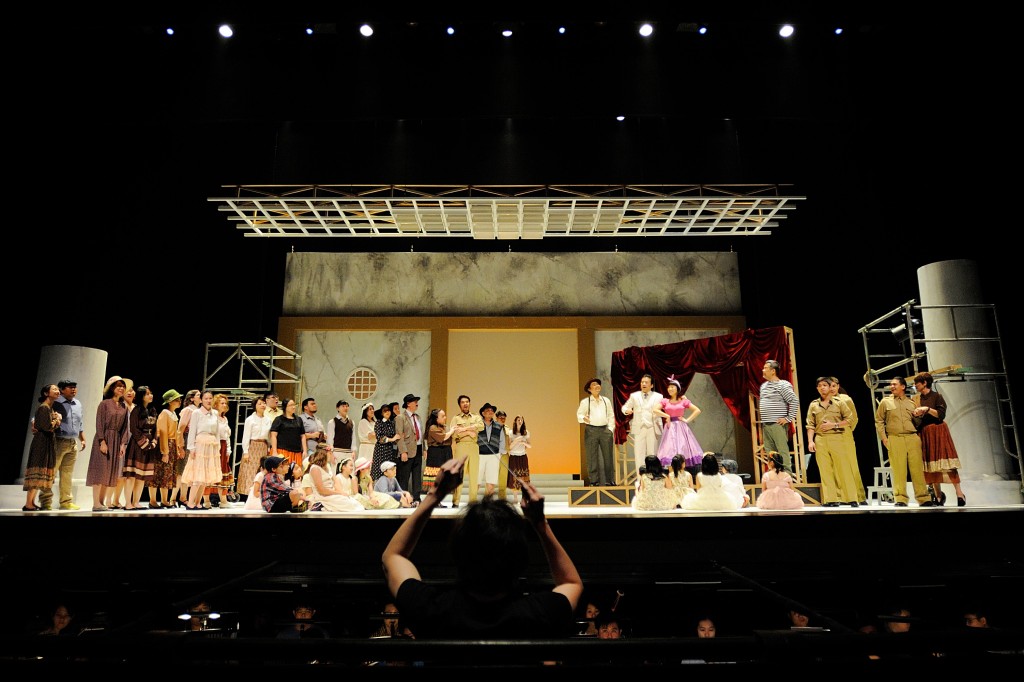Everyone has seen the common theatre symbol before: two masks–one weeping, and the other laughing–representing the Greek Muses of tragedy and comedy.
This symbol is mirrored in Singapore Lyric Opera (SLO)’s recently concluded double bill operas, featuring the tragedy Pagliacci by Leoncavallo and the comedy Gianni Schicchi by Puccini.
Held at the Esplanade Theatre for only three days (10 to 12 September), the production was led by world-renowned director Tom Hawkes and featured an international cast from all over the world – Japan, Philippines, Korea, New Zealand, England as well as Singapore.
The first opera, Leoncavallo’s Pagliacci, was a typical Italian opera tragedy, but with a twist – it featured a play-within-a-play. The two-act opera follows the actor Canio (played by Lee Jae Wook) and his wife both onstage and off, Nedda (Sachika Ito). The climax occurs when Canio confronts Nedda about her lover, right in the middle of a play.
Alas, Canio is unable to put reality aside and continue with the script, and instead demands her lover’s name (Silvio, by Martin Ng). Poor Nedda is fatally stabbed and Silvio rushes to save her, only to be murdered himself. Canio then turns to the audience, remarking bitterly, “The comedy has ended!”.

The second opera, Gianni Schicchi, was a one-act comedy featuring the eponymous clever rogue.
A rich man, Buoso Donati, dies, and his relatives pretend to mourn his passing, thinking that he has bequeathed his wealth to them. However, when they discover that he has given everything to charity, their grief turns to rage and they scheme to find a way around the will.
Rinuccio, Buoso Donati’s nephew, suggests bringing in his prospective father in law, Gianni Schicchi, whom he respects for his quick wit and vast knowledge. Skeptical but left without alternatives, the relatives agree.
As expected, our witty leading character turns the tables round on the hypocritical and condescending relatives, and manages to take the inheritance for himself. Again, the opera ends with a flourish as Gianni addresses the audience, proclaiming himself “Not guilty!”.
The SLO Opera Chorus and SLO Children’s Choir played the ensemble for Pagliacci. Both stories were also accompanied by wonderful live music from the SLO Orchestra, conducted by local conductor Joshua Tan Kangming. The superb music truly carried much of both operas’ souls. The music brought both stories to life, such as when, in Gianni Schicchi, Marlena Devoe’s interpretation of the famous aria Oh! mio babbino caro drew a standing ovation from the audience.
Among my personal favourite moments was Pagliacci’s play-within-a-play, when Nedda and Canio put on clown costumes and acted on the mock stage at the town square. Also remarkable were the suitably comedic timed moments as the relatives jostled to keep the news of Busco Donati’s death within the confinement of his room, and as their attitudes to Gianni Schicchi changed when they saw how he could help them. Though all the cast members were exemplary in their roles, Lee Jae Wook (as Canio in the first opera, and Rinuccio in the next) in particular stood out for his versatility, being able to play both a middle-aged man as well as a youth.
Though both operas were performed in Italian, English and Chinese subtitles made them accessible to the Singaporean crowd. Tickets were also affordably priced at the $20 range. It is heartening to know that opera is now more widely available to students and the general public.
If you’ve been convinced so far about the entertainment value of opera, check out SLO’s upcoming gala concert this November, celebrating its 25th year.




